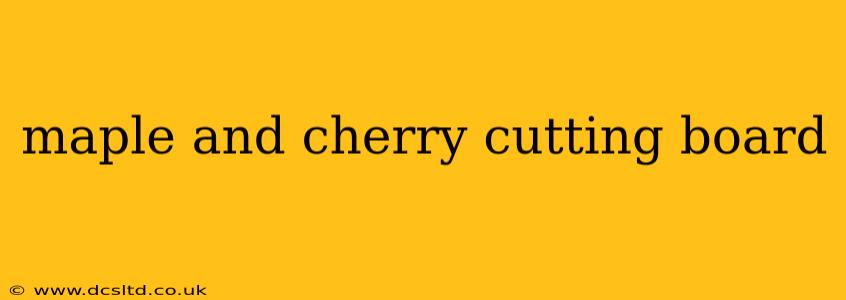Choosing a cutting board can feel overwhelming. Do you prioritize looks, durability, or ease of maintenance? When it comes to wood cutting boards, maple and cherry are popular choices, each boasting unique qualities. This guide will delve into the differences between maple and cherry cutting boards, helping you select the perfect board for your kitchen.
What are the benefits of a maple cutting board?
Maple is a hardwood known for its exceptional hardness and density. This translates to a highly durable cutting board that resists scratches and knife marks better than many softer woods. Its tight grain also minimizes the risk of bacteria harboring in the wood's crevices. Maple cutting boards are renowned for their longevity; with proper care, they can last for decades. Furthermore, maple's light, almost creamy color is aesthetically pleasing, offering a clean and bright look to any kitchen.
What are the benefits of a cherry cutting board?
Cherry wood, another excellent hardwood choice, offers a beautiful, rich reddish-brown hue that deepens with age, developing a unique patina over time. While slightly softer than maple, cherry still provides excellent durability and resistance to damage. Its beautiful color and grain pattern make it a stunning addition to any kitchen countertop. Like maple, cherry's tight grain structure minimizes the potential for bacterial growth.
Which is better: maple or cherry?
There's no single "better" choice; the ideal wood depends on your preferences and priorities. If durability and resistance to scratches are paramount, maple is the slightly better option due to its higher density. If aesthetics are your top priority, and you appreciate a warm, rich tone that ages gracefully, cherry is the more attractive choice. Both are excellent choices for hygiene, providing safe and effective cutting surfaces.
How do I care for my maple or cherry cutting board?
Proper care is essential to extend the life of any wooden cutting board. Both maple and cherry benefit from regular oiling with mineral oil (food-grade) to keep them conditioned and prevent cracking. Avoid soaking the boards in water, as this can lead to warping or damage. Hand washing with warm soapy water is recommended, followed by thorough drying.
Are maple and cherry cutting boards safe to use?
Yes, both maple and cherry are safe for food preparation when properly maintained. However, it's crucial to avoid using abrasive cleaners or bleach, as these can damage the wood and potentially leach into your food.
How long do maple and cherry cutting boards last?
With proper care, both maple and cherry cutting boards can last for many years, even decades. Their durability and resistance to damage ensure they'll remain a functional and attractive part of your kitchen for a long time.
What is the difference in price between maple and cherry cutting boards?
Pricing can vary depending on the size, thickness, and maker of the cutting board. Generally, there isn't a significant price difference between maple and cherry cutting boards of similar size and quality. The price is more often determined by the size and craftsmanship than the type of wood.
Are there other wood types for cutting boards besides maple and cherry?
Yes, many other hardwoods are used for cutting boards, including walnut, oak, and beech. Each wood offers a unique combination of durability, aesthetics, and price. Consider your preferences and needs when choosing a cutting board.
By carefully considering the characteristics of each wood – maple’s superior hardness and cherry's rich color – you can select the perfect cutting board to enhance both your culinary experience and your kitchen's aesthetic appeal. Remember that proper care is key to maximizing the lifespan and beauty of your chosen board.
